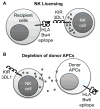HLA Mismatching Favoring Host-Versus-Graft NK Cell Activity Via KIR3DL1 Is Associated With Improved Outcomes Following Lung Transplantation
- PMID: 28375571
- PMCID: PMC5519429
- DOI: 10.1111/ajt.14295
HLA Mismatching Favoring Host-Versus-Graft NK Cell Activity Via KIR3DL1 Is Associated With Improved Outcomes Following Lung Transplantation
Abstract
Chronic lung allograft dysfunction (CLAD) is linked to rejection and limits survival following lung transplantation. HLA-Bw4 recipients of HLA-Bw6 grafts have enhanced host-versus-graft (HVG) natural killer (NK) cell activity mediated by killer cell immunoglobulin-like receptor (KIR)3DL1 ligand. Because NK cells may promote tolerance by depleting antigen-presenting cells, we hypothesized improved outcomes for HLA-Bw4 recipients of HLA-Bw6 grafts. We evaluated differences in acute cellular rejection and CLAD-free survival across 252 KIR3DL1+ recipients from University of California, San Francisco (UCSF). For validation, we assessed survival and freedom from bronchiolitis obliterans syndrome (BOS), retransplantation, or death in 12 845 non-KIR typed recipients from the United Network for Organ Sharing (UNOS) registry. Cox proportional hazards models were adjusted for age, gender, ethnicity, transplant type, and HLA mismatching. HVG-capable subjects in the UCSF cohort had a decreased risk of CLAD or death (hazard ratio [HR] 0.57, 95% confidence interval [CI] 0.36-0.88) and decreased early lymphocytic bronchitis. The HVG effect was not significant in subjects with genotypes predicting low KIR3DL1 expression. In the UNOS cohort, HVG-capable subjects had a decreased risk of BOS, retransplant, or death (HR 0.95, 95% CI 0.91-0.99). Survival improved with the higher-affinity Bw4-80I ligand and in Bw4 homozygotes. Improved outcomes in HVG-capable recipients are consistent with a protective NK cell role. Augmentation of NK activity could supplement current immunosuppression techniques.
Keywords: immunobiology; lung (allograft) function/dysfunction; lung transplantation/pulmonology; major histocompatibility complex (MHC); natural killer (NK) cells/NK receptors; translational research/science.
© 2017 The American Society of Transplantation and the American Society of Transplant Surgeons.
Conflict of interest statement
The authors of this manuscript have no conflicts of interest to disclose as described by the American Journal of Transplantation.
Figures




Similar articles
-
KIR and their HLA Class I ligands: Two more pieces towards completing the puzzle of chronic rejection and graft loss in kidney transplantation.PLoS One. 2017 Jul 7;12(7):e0180831. doi: 10.1371/journal.pone.0180831. eCollection 2017. PLoS One. 2017. PMID: 28686681 Free PMC article.
-
Donor KIR3DL1/3DS1 gene and recipient Bw4 KIR ligand as prognostic markers for outcome in unrelated hematopoietic stem cell transplantation.Biol Blood Marrow Transplant. 2009 Nov;15(11):1366-75. doi: 10.1016/j.bbmt.2009.06.015. Biol Blood Marrow Transplant. 2009. PMID: 19822295
-
Investigation of Killer Immunoglobulin-like Receptor (KIR) and HLA Genotypes to Predict the Occurrence of Acute Allograft Rejection after Kidney Transplantation.Iran J Allergy Asthma Immunol. 2017 Jun;16(3):245-255. Iran J Allergy Asthma Immunol. 2017. PMID: 28732438
-
Natural killer (NK) cell receptor-HLA ligand genotype combinations associated with protection from HIV infection: investigation of how protective genotypes influence anti HIV NK cell functions.AIDS Res Ther. 2017 Sep 12;14(1):38. doi: 10.1186/s12981-017-0172-9. AIDS Res Ther. 2017. PMID: 28893287 Free PMC article. Review.
-
Human leukocyte antigen Bw4 and Bw6 epitopes recognized by antibodies and natural killer cells.Curr Opin Organ Transplant. 2014 Aug;19(4):436-41. doi: 10.1097/MOT.0000000000000103. Curr Opin Organ Transplant. 2014. PMID: 24977435 Free PMC article. Review.
Cited by
-
Natural killer cells activated through NKG2D mediate lung ischemia-reperfusion injury.J Clin Invest. 2021 Feb 1;131(3):e137047. doi: 10.1172/JCI137047. J Clin Invest. 2021. PMID: 33290276 Free PMC article.
-
NKG2C Natural Killer Cells in Bronchoalveolar Lavage Are Associated With Cytomegalovirus Viremia and Poor Outcomes in Lung Allograft Recipients.Transplantation. 2019 Mar;103(3):493-501. doi: 10.1097/TP.0000000000002450. Transplantation. 2019. PMID: 30211828 Free PMC article.
-
Short airway telomeres are associated with primary graft dysfunction and chronic lung allograft dysfunction.J Heart Lung Transplant. 2023 Dec;42(12):1700-1709. doi: 10.1016/j.healun.2023.08.018. Epub 2023 Aug 28. J Heart Lung Transplant. 2023. PMID: 37648073 Free PMC article.
-
Protective and pathogenic functions of innate lymphoid cells in transplantation.Clin Exp Immunol. 2023 Jul 5;213(1):23-39. doi: 10.1093/cei/uxad050. Clin Exp Immunol. 2023. PMID: 37119279 Free PMC article. Review.
-
Screening and identification of key regulatory connections and immune cell infiltration characteristics for lung transplant rejection using mucosal biopsies.Int Immunopharmacol. 2020 Oct;87:106827. doi: 10.1016/j.intimp.2020.106827. Epub 2020 Aug 10. Int Immunopharmacol. 2020. PMID: 32791489 Free PMC article.
References
-
- HHS/HRSA. OPTN/SRTR 2012 Annual Data Report. 2014.
-
- Yusen RD, Edwards LB, Kucheryavaya AY, Benden C, Dipchand AI, Dobbels F, et al. The registry of the International Society for Heart and Lung Transplantation: thirty-first adult lung and heart-lung transplant report--2014; focus theme: retransplantation. J Heart Lung Transplant. 2014;33(10):1009–24. - PubMed
-
- Verleden GM, Raghu G, Meyer KC, Glanville AR, Corris P. A new classification system for chronic lung allograft dysfunction. J Heart Lung Transplant. 2014;33(2):127–33. - PubMed
-
- Todd JL, Palmer SM. Bronchiolitis obliterans syndrome: the final frontier for lung transplantation. Chest. 2011;140(2):502–8. - PubMed
-
- Rajalingam R. Polymorphic KIR-HLA System Regulates Natural Killer Cell Response. In: Ratcliffe M, editor. Encyclopedia of Immunology. Elsevier; 2016. pp. 369–80.
MeSH terms
Substances
Grants and funding
LinkOut - more resources
Full Text Sources
Other Literature Sources
Medical
Research Materials

